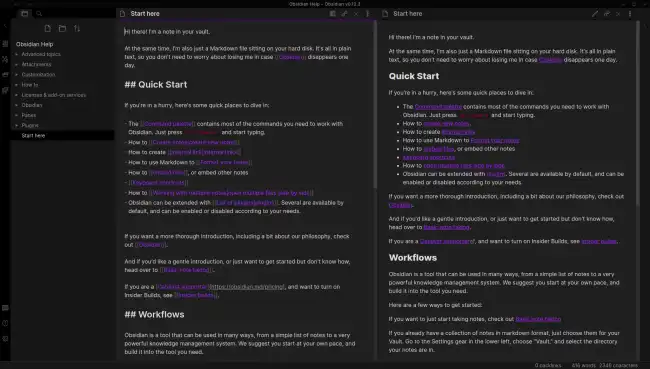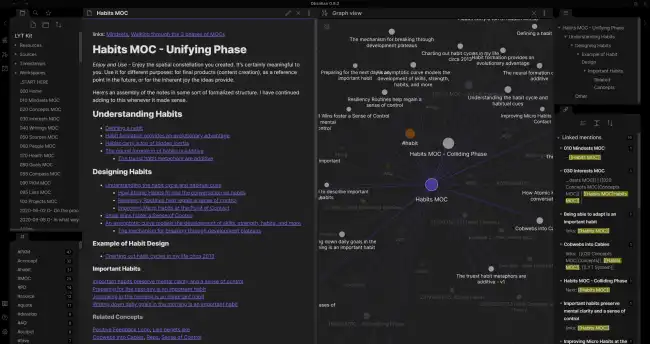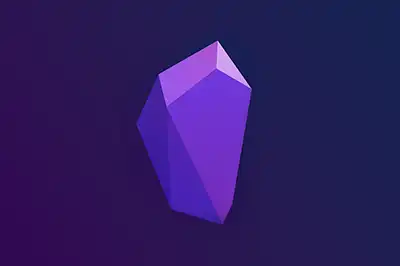Obsidian is a free application that allows taking notes using Markdown format that has gained great popularity recently.
Having a note-taking tool is very important to improve your organization and productivity, both for personal and professional use.
So there are a lot of applications aimed at this. Over time we have Trello, Evernote, or Notion, as popular tools at different times to organize your notes.
Here we have already seen Joplin, which is a very similar application even aesthetically to Obsidian, but Open Source.
Now the fashionable application in the field is Obsidian. This is based on the concept of interconnected notes. The idea is that you can create notes on any topic, and then connect them to create a network of information.
The notes are taken in Markdown format, which as we know is a lightweight markup language that allows for quick and easy formatting.
One of the strong points of Obsidian is that it works directly with Markdown files. What you modify, you are modifying directly in your markdown notes.
It is a great advantage, for example, compared to Joplin, which allows importing and exporting Markdown files, but saves them internally in its database. Which is a hassle, I’m not going to be importing and exporting my notes all day.

We can have several Vaults or work folders. A Vault is nothing more than a folder on our computer, where we store the Markdown files, along with a folder that Obsidian uses to store its configuration.
Aesthetically, Obsidian is very similar to other similar applications, including Joplin or even Visual Studio Code itself. Basically on the left we have a dropdown tree of folders, where we store our markdown files.
The rest of the screen is taken up by a viewer/editor of the markdown file that we have open. In editor mode, also, if we want to see the “normal” mode or the source mode (which I personally usually have active).
Obsidian has tabs to open several notes, the option to pin any of them or mark them as favorites. Of course, also, we can drag them to view them in parallel, both horizontally or vertically.
One of the things I like the most is how it manages attachments and links between notes. If we modify a file, for example by moving it to another location, Obsidian will correctly update the links.
As expected, it also allows us to search and filter our notes very quickly and efficiently. This allows us to find the information we need in a matter of seconds.
Obsidian is compatible with frontmatter in our Markdown notes. In addition, we have the usual command palette, accessible by the keyboard shortcut Ctrl + P, which allows us to execute tools that are not accessible from the graphical environment.
Of course, it has a tagging system. We just have to put #tag in our markdown file to add the tag to our note, as if it were a hashtag on a social network.
However, in my opinion, the tagging system is one of the most improvable points of Obsidian. The available options fall very short. I would prefer a specific bar to add tags, and more tools to manage the existing tags.

On the other hand, we have a graph of interconnected nodes that shows us all our notes, as a constellation. Apart from being very striking, and looking very good on the screen, I frankly find it not very useful.
It also has the concept of ‘Canvas’ as an infinite panel where we can add our notes, along with geometric shapes (rectangles, circles, lines) and texts. This seems much more useful to me.
What is useful is the huge community of plugins that Obsidian has. Some of them are essential and provide a lot of functionality. If you are interested in the topic, I will recommend the ones that seem most interesting to me in other entries.
Regarding the synchronization of notes between devices, as is usually the case, it is a paid option. Which is logical, since it requires someone to pay for the server. But well, having all the notes in a folder, I won’t be the one to tell you (wink wink 😉) that with a Github repo you have the synchronization issue more than solved.
In short, Obsidian is the most popular note-taking application of the moment. And the truth is that, without being anything really revolutionary, it is generally quite good.
Having the notes saved in a folder (instead of an internal data system), along with synchronization through Git, and the plugins, make it a very worthwhile option.
The biggest drawback by far is not being an Open Source application. With all the problems that this entails, and the risk that one day they may decide to offer it for free for personal use.
If we overlook this, Obsidian is a very good tool. It is currently very popular and has a very active community. It fulfills its purpose and is really quite useful for organizing our notes and tasks.
